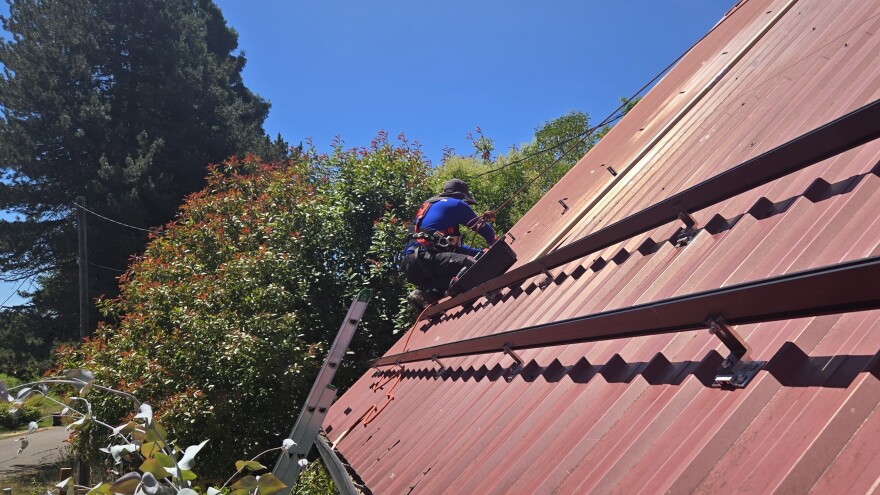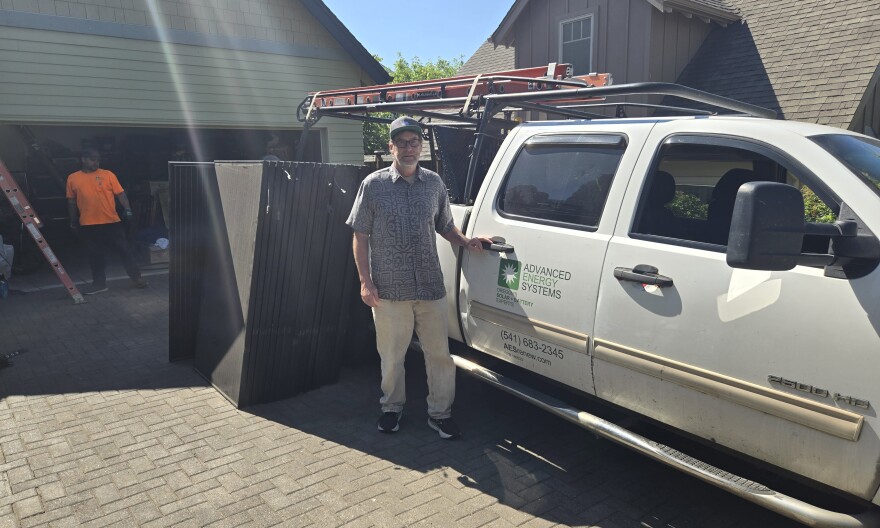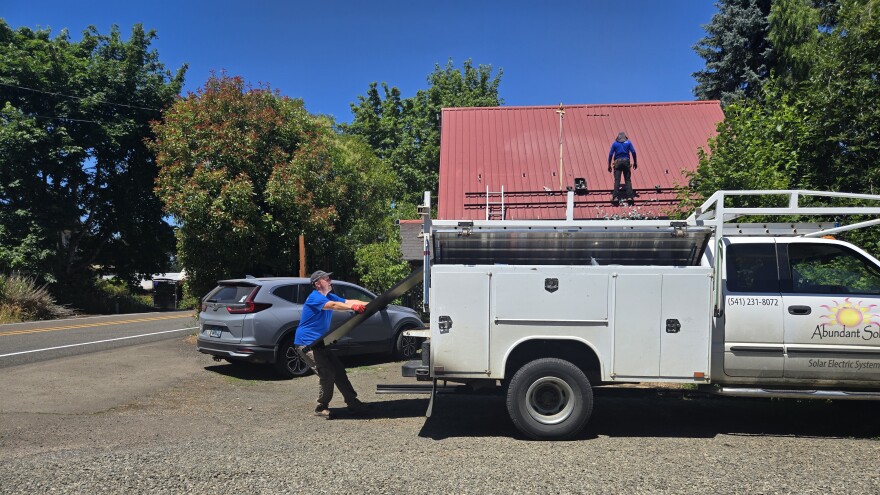It’s a warm, sunny day in rural Linn County; the kind that makes you think that people with their own solar panels are getting their money’s worth.
And one home off Peoria Road will soon be poised to take advantage of days like this. A crew from Corvallis-based Abundant Solar is installing roof racks that will eventually hold the panels for an 8,400-watt array on its steep metal roof.
“It‘s designed to offset about 60% of the customer's annual electrical consumption,” said Abundant Solar Operations Manager Rhine Chesshire.
This is Oregon, so that 60% isn’t evenly spread through the year.
“It's kind of a boom and a bust cycle,” he said. “This particular system will exceed the daily consumption of the household.”
In the summer months, the excess power generated by the panels goes into the grid. The electric utility that services the home credits the owner’s account, and those credits get used later in the year as sunny skies give way to clouds, rain and reduced solar panel production.
Around the time that bank of energy credits could start to get low, it’s possible that another kind of solar credit will end: a federal income tax credit good for 30% of the cost of a system. That's among the provisions in a massive budget package under consideration in Congress.
The House's version of the bill would have ended tax credits for projects that were not in service by the end of the year, but the Senate amended the law to allow projects that begin construction before June 2026 or are producing power by the end of 2027. As of Wednesday, the two chambers still had not agreed on a final version of the bill.
“I think it's going to be an abrupt change. We're going to see a curve tail on investment, for sure. And you know it's, it's unfortunate, because the incentive has paid dividends,” said Chesshire.

The owner of Abundant Solar agrees. Cassandra Robertson started the company with her late husband 20 years ago.
“He moved out to Oregon, and asked me, when we met, ‘what should I do?’ And I said, ‘What do you love?’ He said, ‘I love renewable energy.’ So he got into this field, and when he started to get his Journeyman Electrician, the tax credits weren't even available,” she said.
Robertson said the company has intentionally stayed small through the years so it can better ride the ups and downs of a new but growing industry.
The Interstate Renewable Energy Council estimates that in 2023, Oregon reached 4,177 solar jobs, a growth of about 500 positions from 2018. That report forecasted accelerating growth in 2024, saying jobs would grow at a rate of 10.1% that year.
The Solar Energy Industry Association estimates that 4,400 jobs in Oregon are threatened by an early end to federal solar panel tax credits.
The credit was originally intended to drop to 22% in 2023 and then 10% in 2024. But the Inflation Reduction Act returned the credit to 30% and extended it through 2032 with a two-year taper thereafter.
Now, that timeline appears to be greatly accelerated.
The newly proposed timeline could affect who can afford solar panels on their home or business.
“Most solar customers in Oregon are middle and moderate income, and so that tax credit is really a big part of your decision to be able to go solar in the first place,” said Angela Crowley-Koch, Executive Director of the Oregon Solar and Storage Industries Association.
Crowley-Koch said most solar installations generate enough electricity to cover their cost within about a decade. But the end of the tax credit would add years to that payback time while also possibly putting the initial cost out of reach for some people.
Another longtime solar company, Advanced Energy Systems in Eugene, is also bracing for how an early end to the tax credit would affect business.
When Eric Nill started the company in 2007, the current credits had not yet been adopted, and that changed who their typical customers were.
“There really wasn't much of a rooftop solar industry," he said. "It was more off-grid battery-based systems."
Since then, the group has completed jobs ranging from small home systems to large commercial projects around the state.
Nill has hung photos of the crews who worked on some of his favorite projects on what he calls the company’s Hall of Fame, a literal hallway.
“We worked in Salem at the School of the Deaf. We did a project with the Extreme Makeover: School Edition. Worked all night on that one,” he said, pointing to one of the older pictures.
Advanced Energy Systems’ work is split in close to even thirds between residential, commercial and municipal government projects, meaning the end of federal tax credits would affect most of his company’s work.

“Most of the people that are dabbling or getting interested in solar, they're doing it as a financial investment. And so things like the tax credits or business deductions on your investment, things like that are really vital,” he said.
Nill is worried how the changes will affect his ability to keep his two dozen employees working. He has talked about trying to find more work doing battery backup installations for those who worry about grid stability, or maybe adding another service like air conditioning, at least for a time.
“I do take some solace," he said. "I think there is a certain inevitability with solar. It's the sort of thing where once you have your infrastructure in place, your raw material is free, the sunshine is free."
Back in rural Linn County, Cassandra Robertston said Abundant may also have to find ways to make up for a drop in new customers.
“I am concerned. We’ve kept to a place where we can drum up enough work. We're going to get creative,” she said.
Operations Manager Rhine Chesshire struggles with the inconsistency of cutting the solar tax credit and President Trump’s agenda.
While solar panels are largely made overseas, particularly in China, U.S.-based manufacturing has grown in recent years. The panels Abundant Solar is installing on this day were manufactured in Washington.
“All that economic stimulus that this tax credit has created, it's right in line with this administration's agenda in terms of domestic manufacturing and jobs and grid stability. So it's kind of puzzling,” Chesshire said.
Puzzling to watch as conditions for a growing American industry, from manufacturing to installation, get a little cloudy.





